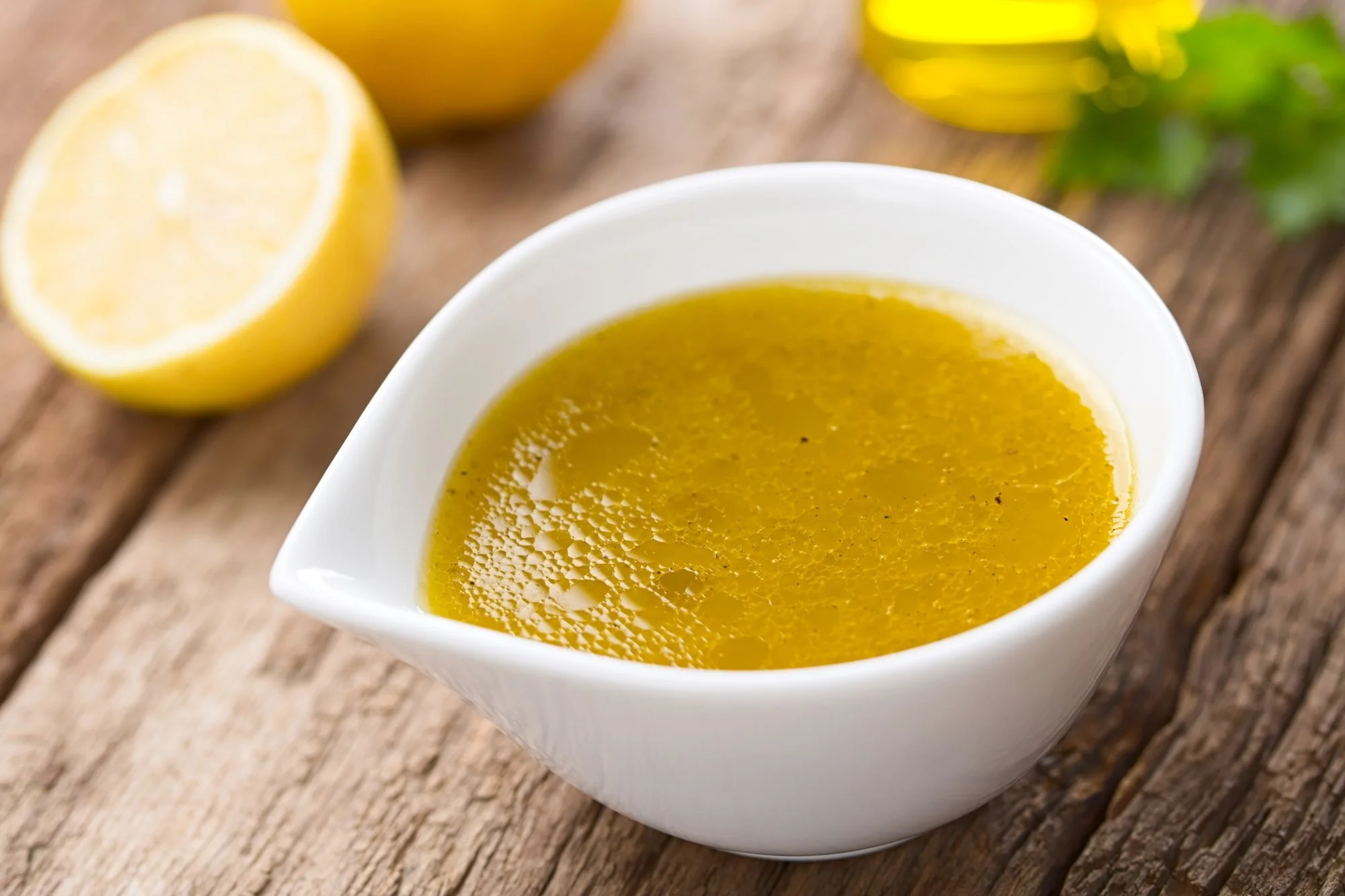Secrets To Making a Great Vinaigrette
Vinaigrette with lemon
Forget all the French "mother sauces," a vinaigrette may be the most versatile cold sauce or dressing of all. While making a vinaigrette is fairly easy, there are infinite variations and secrets to making the best version. Everyone’s secret—to finding lasting love, making irresistible brownies, or whipping up a great vinaigrette—ends up being a little bit different than the next person’s secret.
That’s one of the beautiful things about being a human with an opinion: anything you unabashedly adore isn’t going to look, sound or taste like anyone else’s version of perfect. But. There are a few rock-solid guidelines. (At least for vinaigrette.)
Vinaigrette, not just for salad
Erin Fletter photo courtesy of Sticky Fingers Cooking
For starters, you shouldn’t limit yourself to just using vinaigrette on salad.
“I use vinaigrettes to drizzle over roasted vegetables, to marinate proteins, to elevate simple grains,” says Erin Fletter, five-time cookbook author and founder of Sticky Fingers Cooking. “I use vinaigrettes to drizzle over roasted vegetables, marinate proteins and elevate simple grains. My one go-to is high-quality extra-virgin olive oil, preferable single-origin or sourced from specialty shops.”
The Right Olive Oil Base
Garlic, Olive Oil + Everything Mediterranean
The base of every great vinaigrette is a quality base fat—generally olive oil. But talk to 100 vinaigrette aficionados and you’ll get 100 different responses about the best olive oil.
“My preference is organic cold pressed, extra virgin,” says Tara Punzone, chef and owner of Pura Vita in West Hollywood and co-author of “Vegana Italiana,” with Gene Stone. “Preferably from the south of Italy, like Calabria or Sicily. The flavors are fresh, robust and peppery.”
Buy the best, and keep it simple, advises Daen Lia, home cook, creator of Daen’s Kitchen and best-selling author of Garlic, Olive Oil and Everything Mediterranean, published by Simon & Schuster.
“Less is more when it comes to a beautiful vinaigrette,” Lia says. “Make sure you buy high quality ingredients, especially when it comes to the olive oil.”
The go-to option for a vinaigrette is generally one type of vinegar, many chefs regularly swap vinegar for another form of acid. Bottom line in both cases, buy the best quality you can afford, for consistently bold, clean and better-tasting vinaigrette every time, Punzone says.
Ratios & Swaps
Salad Dressing Lab Presentation Sarah Santa
Another foundational principle of vinaigrette is the base ratio of fat to acid.
“Three parts oil to one part vinegar or citrus works best,” says Fletter. “But you can swap vinegars, citrus juices, sweeteners and even herbs, as long as you don’t compromise on the quality of olive oil and freshness of the acid.”
Lia prefers a different ratio of fat to acid.
“A great rule of thumb that should be applied when making a vinaigrette is that you want two parts olive oil to one part vinegar,” Lia. “You don’t always need a binder, but it’s great to incorporate a teaspoon of mustard as this will bind all the ingredients together and leave you with a smooth and creamy consistency.”
Part of the fun of making and eating vinaigrette is its flexibility—just when you think you’ve found the ideal recipe, it’s time to mix it up.
Sarah Santa
Sarah Santa, a nutrition consultant, olive oil sommelier and founder of June Crush Consulting, touts the opportunity for customization that it presents, and doesn’t spare the foundational ingredients.
Some of the olive oil can be swapped for avocado, sesame or walnut oil, and balsamic vinegar can be switched for sherry, red wine, white wine apple or rice cider—even mirin. Lemon juice can be replaced with lime, orange or grapefruit juice. You can use yellow, Dijon or whole grain mustard, or opt for mayo or miso. Throwing in tahini or another nut butter can round out the flavors, and add richness and texture. For a touch of sweetness, add maple syrup, honey, agave or date syrup.
Mixing methods for Vinaigrettes
Blend
Shake
Whisk
Tara Punzone photo credit Heidi Calvert
There are, once again, many strong and divergent opinions about the best method for crafting the best vinaigrette.
“Emulsify!” instructs Punzone. “It is an excellent technique to learn. In a blender, mix together all of the ingredients except the oil. Once all ingredients are mixed well, and with the blender running on the lowest setting, pour the oil into the top very slowly. This will emulsify the dressing and make it creamy and delicious.”
Fletter, who frequently cooks with kids, prefers the mason jar shake-up method because it’s fun and easy for little hands to do. (Just throw all the ingredients in a jar, secure the lid and shake vigorously).
Santa utilizes a variety of methods, depending on her needs and ingredients on hand.
“Slowly drizzling oil into vinegar as you whisk helps bind the dressing and stabilize the emulsion,” she says. “Shaking all of the ingredients in a tightly sealed jar is a rustic approach, and great as long as you don’t mind a little texture. The blender method provides a creamier consistency.”
Final words of advice: taste as you go, and don’t forget a sprinkle of salt and pepper.
Hungry? Dig into a recipe from Garlic, Olive Oil + Everything Mediterranean: Simple Recipes for the Home Cook, by Daen Lia:
Simple Salad with Lemon & Honey Vinaigrette
Serves 4
Lemon and Honey Vinaigrette and Salad
3½ oz (100 g) salad greens, such as arugula, field greens, kale, radicchio, or oak leaf lettuce
Lemon & Honey Vinaigrette (see below)
¼ red onion, thinly sliced
1¾ oz (50 g) Pecorino Romano, finely shaved
Place the salad greens in a large bowl. Drizzle 2–5 tablespoons (30–75 ml) of the dressing over the top and massage it into the leaves with your hands.
Sprinkle the red onion and Pecorino Romano over the top and serve immediately.
Lemon & Honey Vinaigrette
1 cup (240 ml) extra-virgin olive oil
⅓ cup (80 ml) lemon juice
2 tablespoons honey
Grated zest of 2 lemons
1 heaping teaspoon Dijon mustard
2 garlic cloves, thinly sliced
Sea salt
Freshly ground black pepper
Place all of the ingredients in a large jar with a lid and shake well until combined.
Store in the fridge for several weeks.
Makes 1¼ cups (300 ML)







